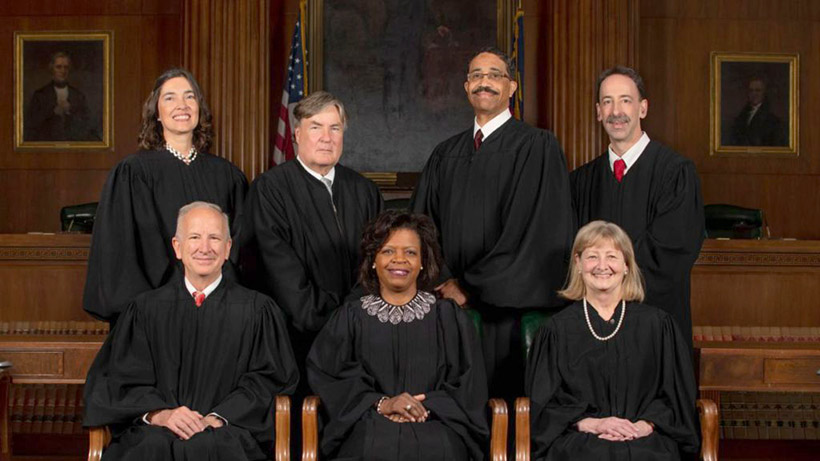Publisher's note: This post appears here courtesy of the Carolina Journal, and written by Mitch Kokai.
N.C. Supreme Court justices, Spring 2019 | Photo: N.C. Courts
You might expect a state Supreme Court with six Democrats and one Republican to end up with a lot of 6-1 decisions with the Republican on the losing end. That's not been the typical scenario this year.
A review of high court decisions reveals a more interesting pattern. It involves two justices with contrasting judicial philosophies who are more likely than the rest of their colleagues to split from the majority in case to case.
Through mid-August, two-thirds of this year's cases have yielded unanimous rulings. And each justice - including the lone Republican - has sided with the majority at least 80% of the time. But those numbers come with a caveat: Data from the entire calendar year tend to overinflate the degree to which the court offers a unified front.
The high court issued its first two batches of mostly unanimous opinions this year as it was dealing with personnel changes. The surprise resignation of Republican Chief Justice Mark Martin led to a shuffle that ended up placing a sixth Democrat on the bench.
Analysis of 2019 decisions could start at the beginning of the calendar year, after Martin's Feb. 28 resignation, or perhaps as late as May 10. That was the first time the court released any opinions dealing with cases heard by the current slate of seven justices.
I'll use the entire year's data, even with its imperfections.
The Supreme Court has decided 41 cases through Aug. 16. Twenty-six of those cases have yielded unanimous rulings, including 10 cases with "per curiam" opinions credited to no individual author. A twenty-seventh case also produced a unanimous result, though Justice Anita Earls wrote a concurring opinion to address legal issues not covered in Justice Sam Ervin IV's majority opinion.
Seven cases (17%) have produced a single dissenting vote. One might expect Republican Justice Paul Newby to be the most likely lone dissenter. He's not. Newby has produced the single no vote in just two cases. In the other five cases with a single dissenter, Earls has stood alone against her colleagues.
Six cases have produced a 4-2 or 5-2 split. Only one case this year ended in a 4-3 division.
Both Earls and Newby have written six dissents. Only once has Earls had a colleague sign on to her dissenting opinion. Newby has convinced a colleague to join his dissent three times.
As these numbers suggest, Newby and Earls are the justices least likely to join the majority. Earls has voted with the majority in 30 of 36 cases (83%), while Newby has sided with the majority in 33 of 41 cases (80%). Subtract the unanimous opinions from Martin's final days as chief justice, and Newby's percentage drops below 78%.
In contrast, Justice Robin Hudson has sided with the majority in all 41 cases. New Chief Justice Cheri Beasley has voted with the majority 40 of 41 times (98%). The newest member, Justice Mark Davis, has voted with the majority in 17 of 18 cases (94%). Ervin and Justice Michael Morgan have voted with the "winning" side in 38 of 41 cases (93%).
Other than Earls and Newby, written dissents have been rare. Hudson, Beasley, and Davis have written none this year. Morgan has written two; Ervin, one.
Earls and Newby have written most often overall as well. With five majority opinions, six dissents, and a concurrence, Earls has been the high court's most prolific writer. Newby ranks second with nine opinions: three for the majority and six in dissent.
Beasley and Hudson have been most likely to agree in their rulings. On the same side in 40 of 41 cases, their agreement rate is 98%. In contrast, Earls and Newby agree least often, 23 of 36 times, or 64%. Earls has no better than an 89% agreement rate with any colleague, and her agreement rates with Ervin and Morgan stand at 75%.
Newby's agreement rates top out at 88% with Ervin and Morgan. Among his other Democratic colleagues, Newby has agreed with Mark Davis 83% of the time; Robin Hudson, 80%; and Beasley, 78%.
The ideological divide separating Earls and Newby comes across particularly clearly in
State v. Grady, a high-profile case involving the future of lifetime satellite-based monitoring for sex offenders. Over the course of 108 pages - 68 from Earls, 40 from Newby - the two justices set out different ideas about the Fourth Amendment implications of lifetime monitoring.
Writing for the 4-2 majority, Earls concludes,
"The SBM program constitutes a substantial intrusion into ... privacy interests without any showing by the State that the program furthers its interest in solving crimes that have been committed, preventing the commission of sex crimes, or protecting the public." Thus Earls and colleagues strike down satellite-based monitoring for offender Torrey Grady and all others in similar circumstances.
Newby responds in dissent:
"Using the [case] as an opportunity to make a broad policy statement, the majority ... applies an unbridled analysis which understates the crimes, overstates repeat sex offenders' legitimate expectations of privacy, and minimizes the need to protect society from this limited class of dangerous sex offenders. The majority's sweeping opinion could be used to strike down every category of lifetime monitoring under the SBM statute."
This case and others suggest that Earls and Newby will continue to spell out their competing views of the law. At least until voters have their next chance to vote on Supreme Court justices in 2020.
Mitch Kokai is senior political analyst for the John Locke Foundation.
























